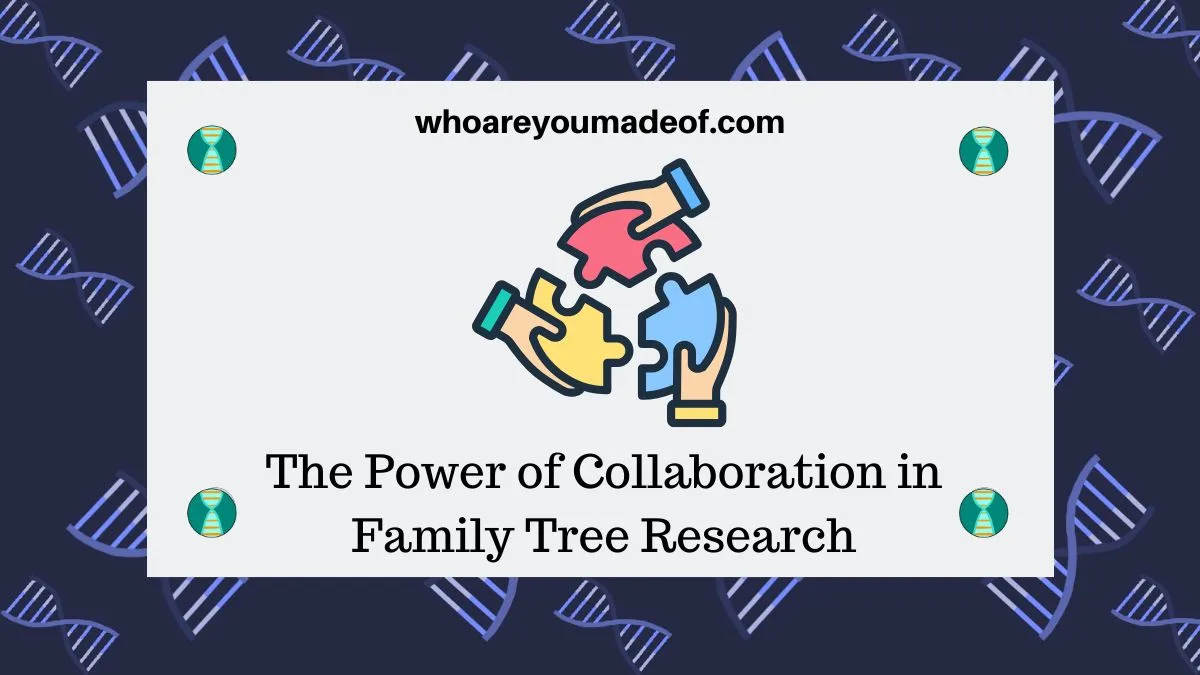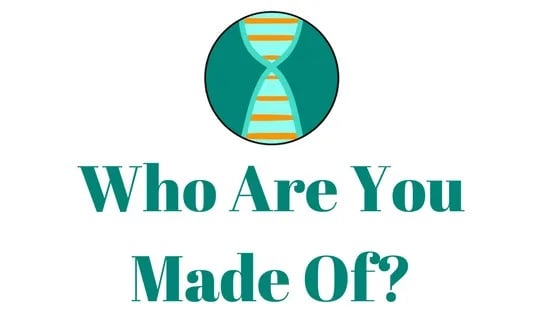Did you know that collaborating and sharing with other family tree researchers might be the key to taking your research to the next level? In this post, learn how you can leverage the power of collaboration to help tell your ancestors' stories.

As the readers of my free newsletter might know, I love to get suggestions about article topics. My goal is to help people learn about topics that interest them.
One of my readers recently suggested an article about collaboration and sharing. A researcher had reached out to her asking whether she had a particular surname in her tree.
Initially, she didn't think that she had any ancestors with that name. However, upon closer examination, she realized that she did, and this discovery helped her determine how more than 35 of her DNA matches were related to her.
And it was all because of a single person who reached out to ask a question!
This is just one simple way that a connection between two people led to a cascade of discoveries. Below, find a myriad of ways that sharing your work (and having other work shared with you) can help you learn things you could never imagine about your family and your ancestors.
Access to additional resources
I'm a huge fan of genealogy. It's my passion and it's my favorite hobby. I do it to relax!
But even I know that family history research takes a lot of time and effort. It can sometimes be expensive, and there are aspects that require special skills.
If we can find other people who are researching the same ancestor or family line that we are, we can work together and share our resources and skills to accomplish shared goals.
Shared resources can be financial
Shared resources can include financial resources, and this can help spread the burden of research between multiple. For example, requesting a copy of vital records can be expensive, ranging from around $15-50 each.
You might have relatives, or a group of relatives, who already have these certificates and who would share a copy with you. It's a way for the resources of multiple people to be shared for the benefit of all.
Skills are easy - and free - to share
One of the best resources to share are skills. One of my siblings and I are working on a family research project on our ancestors from Slovakia and their descendants in the United States.
For our project, we wanted to include copies of all of the birth, marriage, and death records for all of the people involved. My sibling offered to spend the money to get all of the US records if I would use my research and language skills to get the needed records from Slovakia.
Better accuracy
It is often through communication with others that we can correct errors in our family trees. You might have an error, or you might spot an error in someone else's tree.
These small moments of communication between distant family members can often lead to the exchange of additional information, or even just a nice relationship with a cousin.
We all make mistakes
I've had my own fair share of mistakes in my family tree. I'm certainly not immune to making mistakes, since genealogy research can often be confusing.
Is my family the only one that has generations of people using and repeatedly reusing the same first name? When a branch of the family also has the same last name, it can compound confusion, which is what happened to me last year.
I had added a great-granduncle, Oscar, to my family tree. He was a son of my Polish great-great grandfather who, coincidentally, was also named Oscar.
Well, this second Oscar also had a son named Oscar, and his son also named one of his sons Oscar. Since all of these Oscars were males descended from a direct-male line from the first Oscar, they all also shared his last name.
There was lots of potential for getting mixed up! So, it was no surprise when I received this message on Ancestry from a first-cousin twice-removed:

Apparently, I had listed my cousin's mother as his grandmother. My cousin, also an Oscar with the same last name (!), provided me with the name of his spouse and their date of marriage, which was new information to me.
After this initial communication, he also verified the names of his siblings for me, which I wanted to do to make sure that I was correcting information for the right Oscar.
Once he did this, I realized that I had a letter that his sister had written to my grandfather. His sister used her nickname and her married surname, so I hadn't been able to figure out exactly who she was.
Then, I offered to send my cousin a photograph of his great-grandmother. He had never seen a photograph of her, and I had recently found one in my grandfather's papers.
That simple message that my cousin sent me in hopes of correcting an error in my tree opened up a line of communication and collaboration that would not have existed.
Fewer knowledge gaps
Sharing and collaborating with relatives on our family tree research will lead to fewer knowledge gaps in our work. There are many examples of how this can work.
A great example of sharing information to reduce knowledge gaps is when people share their prepared genealogies with each other. My great-grandmother was very interested in genealogy, and so she did a lot of work on her family tree.
All of her research was eventually typed up on a typewriter and bound into a document that has now been digitized. It's easy to share this document with other people, and I usually get some type of information in return.
I can then go through the new information that I receive to find living relatives and other details that I didn't know about to add to my tree.
Sometimes these exchanges can lead to the acquisition of photographs and other documents that you may not have seen before. For example, I have a second cousin who is very adventurous in reaching out to relatives to learn more about their shared ancestry.
You never know what is sitting in someone's attic
In an e-mail to a cousin who is descended from our shared ancestor from Poland, he mentioned the name of my great-grandfather, Peter. The cousin remembered seeing a box of photographs in his mother's attic with the label "Peter's family".
He scanned the photos and sent them to my cousin, who then forwarded them to me. In the photos, we found a photograph of my Polish great-great grandfather sitting in a chair, surrounded by his grandchildren, including my grandmother.
What a treasure! Without my cousin reaching out and wanting to collaborate with others, these photographs may have gone unseen for more decades. There is no way to know where they would have ended up.
Our DNA can close knowledge gaps
One of the best things that we can share is information in the realm of DNA testing and results. The simple act of DNA testing, with a site such as Ancestry or MyHeritage, and allowing our names to appear as DNA matches, is an incredible way to share.
However, we can take our sharing even further in genetic genealogy. For example, attaching a family tree to our DNA results or adding a link to our online tree in our DNA match profile is sharing.
Responding to messages from DNA matches, or contacting interesting matches, are other ways that people share the information that can be learned from their genes.
I have made a seemingly endless list of discoveries through my DNA match list, including discovering how previously unknown close relatives are related, and figuring out the biological parents of a few close and distant relatives. All of this was done through my DNA match list with some contact and sharing with these relatives.
Faster, more efficient shared work
One of the most compelling reasons to share your genealogy work, and have others' work shared with you, is that this is the fastest and most efficient way to do research. Collaboration helps save us time and helps us avoid doing work that has already been done before.
For example, I once was on a road trip through New Jersey and I decided to stop at the church where my great-grand uncle was baptized. I've been working on trying to learn as much as I can about his mother, my great-great grandmother.
The nice woman at the church pulled out the old record books from 1895 and let me take a photograph of his baptismal entry. When I got home, I e-mailed the photograph to my cousins, who also do genealogy work, and then uploaded it to my Ancestry family tree.
The record that I photographed is only available in index form online, and it doesn't include all of the information that I saw at the church. Since I took the time to stop by the church and ask about the record, no one else has to repeat this work.
They can use their limited time to do other work and share it with me. Sharing with family is really the best way to do family tree research.
A more complete family story
Finally, collaborating is the only way to get a more complete family story. We all have experienced only a small piece of our family's story.
By working with other relatives, we can put all of our pieces together to build a more complete patchwork of stories that more accurately illustrates our family's journey through time.
Tips for how to start collaborating with others
Fortunately, collaborating is easy to do. You can share as little or as much as you feel comfortable with, and you might be surprised at what you receive from your relatives in return.
A few ideas and tips for collaboration are below.
Take a DNA test and update your profile
If you haven't taken a DNA test yet, consider taking one. If you've already taken one, be sure that you have a link to your family tree on your profile and that you have filled out your profile completely.
Reach out to your extended family
Contact your extended family, including first and second cousins, aunts and uncles, and great-aunts and uncles. Let them know that you are interested in family tree research and that you would like to know if they have any information that they could share with you.
They might put you in contact with a relative that has already done some research, and this could lead to a collaboration with you.
Reach out to distant relatives researching the same ancestor
If you use a site like Ancestry, you can often find relatives who are researching your shared ancestors through the search function. Search for an ancestor and find the family trees that contain this ancestor, and send them a message.
You could suggest a new piece of information for them - you never know where this will lead.
Conclusion
I hope that you have enjoyed this article about sharing information and working with others, even on a limited basis, in relation to your family tree research. Whether it is DNA information or genealogy records, you will be sure to benefit from shared efforts to learn about your ancestry.
If you have any questions about something that you read in this post, or if you would like to share a story about a shared research experience that really opened up something in your family tree, I would love to hear from you in the discussion below.
Thanks for reading today!
